The Friendly Fire Room Presents
Listen And See
Thank you Wanda Barlow for this great idea!
Pronouns Metaphors Errors Part 5
Pronouns Metaphors Errors Pt 5
To God be the Glory, great things He has done.
mcmtffr.org wishes to acknowledge and thank Derek Konofalski and Rocket Media for making this page:
Mobile Friendly
Pronouns, Metaphors, and Errors
Message
October 26, 2014
Part 5

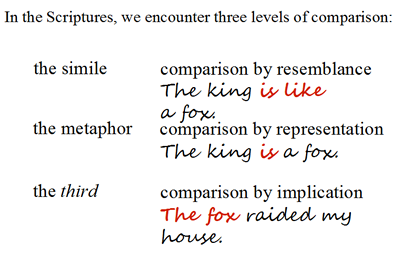

Here is another example of the third type of comparison.
NKJ Luke 13:32
And He [Jesus] said to them, "Go, tell that fox,
'Behold, I cast out demons and perform cures
today and tomorrow,
and the third day I shall be perfected.'
The identity or name which is represented as “the fox” is implied from the greater context, not immediately indicated explicitly, but obviously understood.
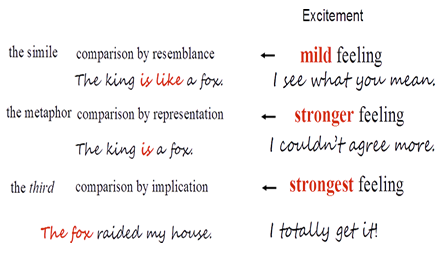

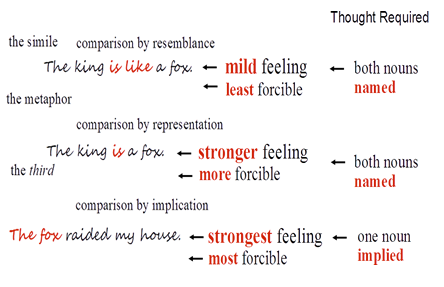
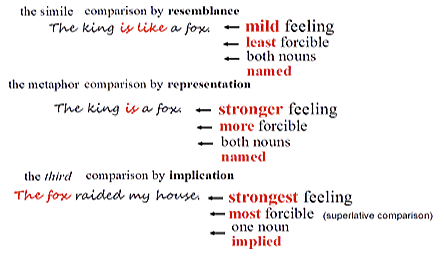

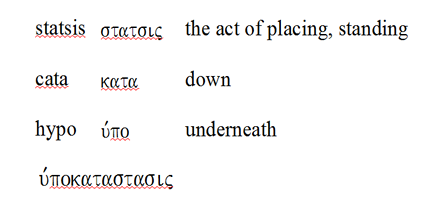
This idea which is applicable in helping us understand some of the differences between these three types of comparisons, comes from something Charles said last night, about narrowing bandwidth.
If we think of the simile as a type of comparison which requires us to keep looking back and forth between two previously unassociated ideas or things, then we might describe that initially huge gap between them as a wide span or bandwidth.
Then, as we become more familiar with, and begin to understand, the actual similarities that exist, the initial span or bandwidth becomes more narrowed, until we are able to think in terms of the simile [comparison by similarity], where the name is relatively close to the figure.
After having invested effort in coming to understand the similarities of the simile, it becomes easier for us to think in terms which narrow the bandwidth down to a side-by-side-kind-of-relationship of the metaphor [comparison by representation], where the name is placed side-by-side with the figure.
After having invested effort in coming to
understand the similarities of the simile, and to
understand the side-by-side representation of the
metaphor, it is easy for us to think in terms which
can be represented by narrowing the bandwidth
down to a precise point on the spectrum scale, to the hypocatastasis [comparison by implication],
where the name of the thing is placed down
underneath the figure.
In Jeremiah 49.19, we read of the king of Babylon coming up against Edom-
NKJ
"Behold, he shall come up like a lion… against the dwelling place of the strong;
Figure: similie
Feeling: mild
Force: least
Name: explicit
In Jeremiah 4.7, we read of the same king of Babylon spoken of as coming up against Zion-
NKJ Hint: Skip the metaphor…
The lion has come up from his thicket,
And the destroyer of nations is on his way.
He has gone forth from his place
To make your land desolate.
Your cities will be laid waste,
Without inhabitant.
Figure: third
Feeling: strongest
Force: most
Name: implied
Psalm 78:51-53
51And destroyed all the firstborn in Egypt,…
52…But He made His own people go forth like sheep, and guided them in the wilderness like a flock;
53And He led them on safely, so that they did not fear;
But the sea overwhelmed their enemies.
Figure: simile
Feeling: mild
Force: least
Name: explicit
Psalm 119:175-176
175 Let my soul live, and it shall praise You;
And let Your judgments help me.
176 I have gone astray like a lost sheep;
Seek Your servant,
For I do not forget Your commandments.
Figure: simile
Feeling: mild
Force: least
Name: explicit
Isaiah 53:5-6
5 But He was wounded for our transgressions, He was bruised for our iniquities;
The chastisement for our peace was upon Him,
And by His stripes we are healed.
6 All we like sheep have gone astray;
We have turned, every one, to his own way;
And the LORD has laid on Him the iniquity of us all.
Figure: simile
Feeling: mild
Force: least
Name: explicit
Jeremiah 50:17

Figure: simile
Feeling: mild
Force: least
Name: explicit
Jeremiah 50:17
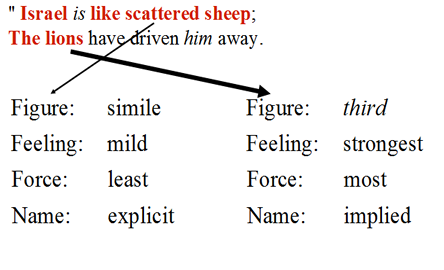
Micah 2:12
" I will surely assemble all of you, O Jacob,
I will surely gather the remnant of Israel;
I will put them together like sheep of the fold,
Like a flock in the midst of their pasture;
They shall make a loud noise because of so many people.
Figure: simile
Feeling: mild
Force: least
Name: explicit

Zechariah 10:2
For the idols speak delusion;
The diviners envision lies,
And tell false dreams;
They comfort in vain.
Therefore the people went their way like sheep;
They are in trouble because there is no shepherd.
Figure: simile
Feeling: mild
Force: least
Name: explicit
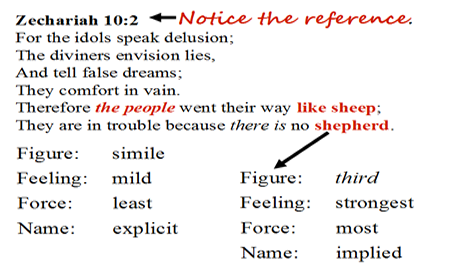
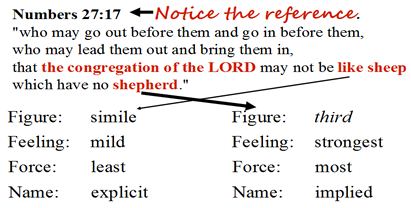
Implication:
Again, the statement that the con- gregation has no shepherd is more important than the statement that the congregation is like sheep.
Matthew 9:35-36![]() Notice the reference.
Notice the reference.
35 Then Jesus went about all the cities and villages,
teaching in their synagogues, preaching the gospel
of the kingdom, and healing every sickness
and every disease among the people.
36 But when He saw the multitudes,
He was moved with compassion for them,
because they were weary and scattered, like sheep
having no shepherd.
Mark 6:34
And Jesus, when He came out, saw a great multitude
and was moved with compassion for them,
because they were like sheep

Figure: metaphor
Feeling: strong
Force: more
Name: explicit
Lesson:
We totally get it that God is the Shepherd of the ages.
When we encounter the figure “Shepherd” in the hypocatastasis form we immediately think of the figure as “God”.
When we encounter the figure “the Shepherd” in the strongest form in the OT, the hypocatastasis, we immediately think of the name underneath the figure as “God”.
When we get to the New Testament, and encounter hypocatastasis references to “the Shepherd”, we have no trouble thinking of the name underneath the figure as “Jesus”.
We also need to make the connection from the NT back to the OT in terms of realizing the major significance of the fact of prophesy having been fulfilled.
Not only is the Shepherd of the OT the Person of Jesus the Christ, the words of the prophets are effectively the words of Christ.
Christ not only spoke these words through faithful servants of God, He personally fulfilled them.
When we looked at John 6.63 last week, the words which Jesus referred to are not limited to those which He had spoken while on earth, but also to the words which He had spoken through the prophets.
…the words which Christ has spoken to us,
the abiding result of which is in us presently, is
spirit and life in quality and character, able to be
of beneficial assistance to the work of the Holy Spirit
in effectually creating spirit quality and life quality
in us who are true believers.
Matthew 10:5-7
These twelve Jesus sent out and commanded them, saying:
"Do not go into the way of the Gentiles, and do not enter

Figure: third
Feeling: strongest
Force: most
Name: implied
1 Peter 2:25
For you were like sheep going astray,
but have now returned to the Shepherd and Overseer of your souls.
Figure: third
Feeling: strongest
Force: most
Name: implied
NKJ Jeremiah 23:1
"Woe to the shepherds who destroy and scatter the sheep of My pasture!" says the LORD.
Many will be surprised on the Day of Judgment when they discover that it was just as the Word of God says; only the righteousness of Christ is able to save you.
All men are sinners and no one can save himself. God is just, so He must punish sin; but He is also merciful, moreover gracious, and offers His Son as the perfect sacrifice in order to purchase a place for you in heaven, which He offers to you as the free gift of eternal life.
Jesus is the Christ, the Messiah, the Anointed One, He is God Incarnate.
In order to pay the debt of our sins,
He came from Heaven, having been sent by the Father,
where He lived a life of perfect obedience to the Father
even unto the shameful death upon the cross
in order to pay the debt of your sins.This gift must be received by faith,
believing that Jesus’ perfect life and Cross Work
was His complete and necessary Atonement
for your sins, in your behalf.
Faith is a gift that comes by the Power of God the Holy Spirit working in a person’s innermost being.
Only the power of God can open your heart to the willingness to have the void within it filled
with the presence of Christ by His Spirit.The Holy Spirit has the authority and power to quicken your dead spirit, to make it come to life.
Only the life of His Spirit’s quickening of your heart will allow the Gospel message of salvation to even make sense to you, to truly “hear” the message and give you the ability,
as the Holy Spirit bears witness to Jesus,
to recognize your need for forgiveness and restoration, and gain the desire of your heart to be favorably inclined to want to receive Christ as your personal Lord and Savior. If you have not done so before this moment,
ask Jesus to forgive you your sins,
tell Him you’ve stop trying to be your own savior,
and ask Him to come into your life right now,
and to give you eternal life.
Then, in faith believing,
thank Him for the gift that He is giving you,
the one He paid for in full in your place,
in Jesus’ name,
AMEN
Copyright October, 2014
Rev. Jim Craig
All Rights Reserved
Bibliography
Agnes, Michael and Charlton Laird (eds.). Webster’s New World Dictionary and Thesaurus. New York, NY: Macmillan, 1996.
Aland, Kurt, Matthew Black, Carlo M. Martini, Bruce M. Metzger, and Allen Wikgren (eds.). The Greek New Testament, 4th rev. ed. Germany: Biblica-Druck, 1994.
Benner, Jeff A. The Ancient Hebrew Lexicon of the Bible. College Station, Texas: Virtualbookworm.com Publishing Inc., 2005
Bullinger, E. W. Figures of Speech Used in the Bible; Explained an Illustrated. Grand Rapids, Michigan: Baker Book House, 2007.
Chapman, Benjamin. Greek New Testament Insert. Grand Rapids, Michigan: Baker Book House, 1977.
Dana, H. E., and Julius R. Mantey. A Manual of the New Testament. Canada: The Macmillan Company, 1957.
Louw, Johannes P. and Eugene A. Nida. Greek-English Lexicon of the New Testament Based on Semantic Domains. New York, NY: United Bible Societies, 1989.
The ESV Study Bible. Wheaton, Illinois: Crossway, 2011.
Metzger, Bruce M. Lexical Aids for Students of New Testament Greek. Princeton, New Jersey, 1977.
Wikipedia contributors. "Xenophon." Wikipedia, The Free Encyclopedia. Wikipedia, The Free Encyclopedia, 15 Aug. 2014. Web. 19 Aug. 2014.
Wuest, Kenneth S. The New Testament; An Expanded Translation. Grand Rapids, Michigan, 1992.
Wuest, Kenneth S. (Revised, Donald L. Wise). The Practical Use of the Greek New Testament, rev. ed. Chicago, Il: Moody Press, 1982.
Walsh, J. Martyn and Anna Kathleen Walsh. Plain English Handbook: A Complete Guide to Good English, 7th rev. ed. Cincinnati, Ohio: McCormick-Mathers PublishingCompany,1977.